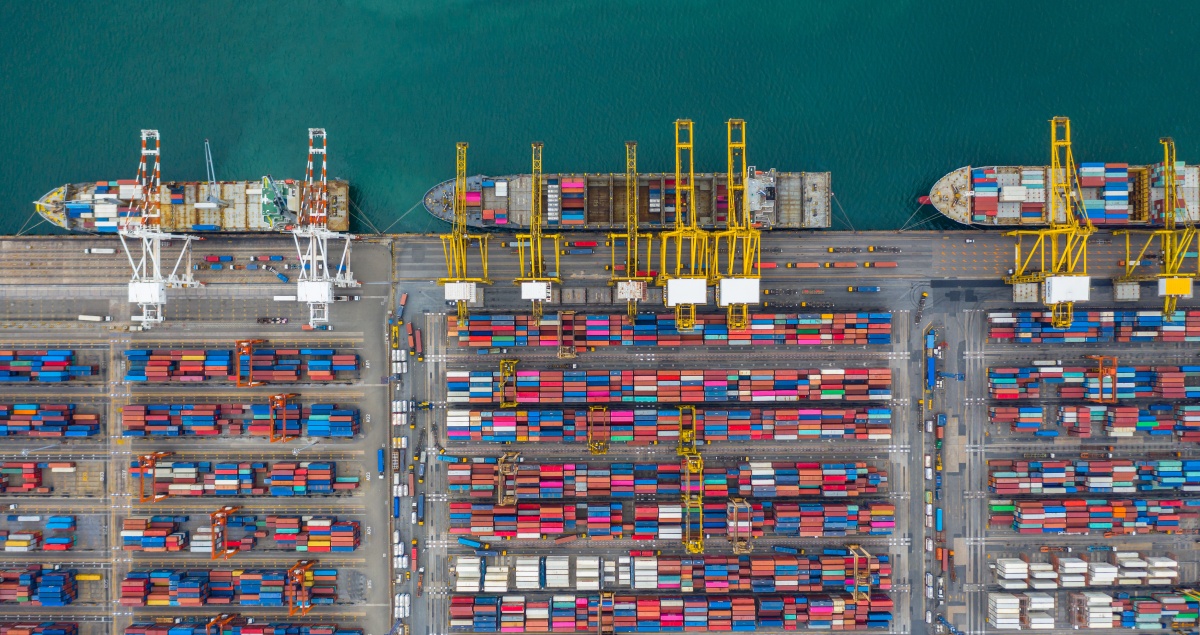The case for international free trade, and the political role that the United States has played in shaping international trade policy, has consistently provoked controversy, particularly in recent years. However, since the Great Depression, the U.S. has nevertheless taken the lead in setting the agenda for a policy of freer trade across all nations. The Smoot-Hawley tariff of 1930, which pushed the average tariff on imports to 50%, was among the most important factors that deepened the Great Depression, later solidifying the political case for an economic policy of multilateral free trade. U.S. secretary of state for the FDR administration, Cordell Hull, became the primary architect of a new economic policy. Although he is better known as “the Father of the United Nations,” Hull also played a crucial role in the formation of the General Agreement on Tariffs and Trade (GATT), which was the forerunner of the World Trade Organization (WTO). For his efforts in fostering international peace, Hull was awarded the Nobel Peace Prize in 1945. Hull’s policies were based on the belief that free trade was a positive-sum game leading not only to economic prosperity but also to international peace. In effect, Hull heeded the words attributed to the French economist Frédéric Bastiat, who is often quoted as saying, “If goods don’t cross borders, armies will.”
For years, under both Democratic and Republican administrations, the U.S. has been pursuing policies detrimental to international free trade, and thus a threat not only to domestic prosperity but also to world peace. Here’s a blueprint to reverse course and prevent disaster.
Unfortunately, both in rhetoric and practice, U.S. trade policy has increasingly retreated from multilateral free trade as a means of promoting peace and prosperity. Instead, however much disguised in “free trade” rhetoric, discussions of international trade have become increasingly antagonistic. Although President Obama secured the Trans-Pacific Partnership (TPP), which would have reduced trade barriers between 11 countries around the Pacific Rim, including Japan, trade policy has remained framed in terms of protecting American workers from unfair competition, particularly from China. For example, in his State of the Union address on January 20, 2015, President Obama asserted that
21st-century businesses, including small businesses, need to sell more American products overseas. Today our businesses export more than ever, and exporters tend to pay their workers higher wages. But as we speak, China wants to write the rules for the world’s fastest‐growing region. That would put our workers and businesses at a disadvantage. Why would we let that happen? We should write those rules. We should level the playing field. That’s why I’m asking both parties to give me trade promotion authority to protect American workers, with strong new trade deals from Asia to Europe that aren’t just free, but fair.
This inflammatory political rhetoric on trade was then put into practice by President Trump’s series of retaliatory tariffs and trade war with China. Perhaps more than any other president in the post-WWII era, President Trump retreated from a policy of multilateral and freer trade in favor of greater protectionism. Not only did Trump withdraw from the TPP agreement established by the Obama administration; he also erected trade barriers on imported steel, aluminum, and other products. The Biden administration, unfortunately, has also sent mixed messages on trade policy. The president’s Trade Agenda Report, released by the White House on March 1, 2021, states that trade policy “is an essential part of the Build Back Better agenda. Trade must protect and empower workers, drive wage growth, and lead to better economic outcomes for all Americans. The Biden Administration will review past trade policies for their impacts on, and unintended consequences for, workers.” Although the report states that restoring “U.S. leadership around the world and repairing partnerships and alliances are Biden Administration priorities,” which seems to reverse the course of the Trump administration on trade policy, it also signals a continued antagonistic posture toward China: “The Biden Administration recognizes that China’s coercive and unfair trade practices harm American workers, threaten our technological edge, weaken our supply chain resiliency, and undermine our national interests.”

Given that the Biden administration has claimed that its trade agenda is central to recovering from COVID-19, lifting underserved communities from poverty, and “building back better,” the question that should be raised is, What is the most effective trade policy to achieve these stated objectives? I argue that the most effective way to meet these objectives is to reclaim our post-WWII commitment to a multilateral free trade and to restore the constitutional basis for such trade policy. Such a commitment to multilateral free trade, which neither discriminates against nor favors particular parties through bilateral trade agreements, would extend to every trading partner of the U.S. the lowest possible tariffs, which ideally would be zero. Moreover, there is also a traditional American basis, if not always practice, for extending a multilateral posture toward international trade in a peaceful manner, going as far back as President George Washington’s 1796 Farewell Address, in which he eloquently declared:
Harmony, liberal intercourse with all nations, are recommended by policy, humanity, and interest. But even our commercial policy should hold an equal and impartial hand: neither seeking nor granting exclusive favors or preferences; consulting the natural course of things; diffusing and diversifying by gentle means the streams of commerce but forcing nothing.
Before discussing how to restore the constitutional basis for such trade policy, it is important, first, to discuss some misperceptions about the nature of international free trade, along with its potential objectives, and reiterate the economic, political, and social benefits of free trade consistent with the national interest of the U.S.
One misperception about international trade is that it is based primarily on an increase in the exchange of goods and services consumed directly as final output across international borders. Think automobiles and appliances. Although the opponent of free trade might insist that freer trade implies that an increasing amount of goods and services will be purchased from abroad, there is an important reason why the slogan “Buy American” is misleading. What has driven international trade in the post-WWII era, particular for the U.S., is increased trade of immediate goods, or components used in the production of final consumer goods here in the U.S., creating more fine-grained specialization that transcends political borders. This trend is what international trade economist Douglas Irwin refers to in his book Free Trade Under Fire as “vertical specialization.” Although this increase in vertical specialization can be explained by a general decline in tariffs, quotas, and other trade barriers, another important yet relatively unknown factor that explains this international trend has been the advent of “containerization.” As Marc Levinson explains in his book The Box, Malcolm McLean, the pioneer of containerization, discovered in the 1950s a way to profit from a reduction in the cost of transporting goods: the utilization of cranes to transport containers directly onto truck trailers or railcars, thereby eliminating the process of loading and unloading by hand. Loading time was reduced from days to less than 8 hours on that maiden voyage of the first container ship, Ideal-X, in 1956, and according to Levinson reduced the cost of shipping from $5.83 per ton to 15.8 cents per ton. According to estimates provided by Irwin, vertical specialization has accounted for about half the growth in U.S. trade since the 1960s and about a third of the increase in world trade since 1970. Because an increasing proportion of goods that are “made in America” include components and inputs from abroad, the notion that goods produced in the U.S. are 100% “American” has become increasingly inaccurate and therefore contrary to any plea to “Buy American.” Without those foreign components, or inputs, there would not be anything “American” to buy.
Multilateral free trade is in the best interest of the United States as a whole, since it provides the instrument necessary for international peace and decreasing the likelihood of a shooting war, not just a trade war, with China—or any other country for that matter.
One misperception regarding bilateral “free trade” agreements is that they have resulted in freer trade. The international trend away from multilateral and nondiscriminatory free trade, as had been characterized by trade agreements extending equally across members under GATT, has been due to a relative increase in preferential trade agreements. Under GATT, which followed a “Most Favored Nation” (MFN) principle, any member of a trade treaty would receive the same lowest tariff enjoyed by the country acting as its signatory. Thus, if the U.S. and Italy agreed to a reduction in tariffs to 5%, all other countries would also benefit from the same trade reduction as well. However, the reality has been that the rise of so-called free trade agreements is in fact what are known as “preferential trade agreements” (PTAs), which are intended to manage trade in a discriminatory manner, not enhance truly free trade in a multilateral manner. The proliferation of PTAs has unintentionally resulted in a “spaghetti bowl effect,” as dubbed by international economist Jagdish Bhagwati in his book Termites in the Trading System. Because trade agreements are not extended unilaterally, the spaghetti bowl effect requires hundreds of pages to outline “rules of origin,” product-specific requirements, and other regulations to specify between trading partners whether they are eligible for a preferential tariff rate.
Thus, to the extent that the Biden administration has proffered a trade agenda focused on economic growth and “reopening the economy” as it recovers from the pandemic, then multilateral free trade would be the most effective means of doing so. The reason for this is that PTAs, contrary to the perception that they provide the means of freeing trade, in fact manage trade by distorting trade and investment to the benefit of special interest groups. If PTAs were really about freeing trade, then they wouldn’t require hundreds of pages of regulation to specify the terms of trade. Instead, the complexity of PTAs, with all its “trade-related” specifications, are in reality a disguise for what economists refer to as “rent-seeking,” which is the expenditure of time and resources by individuals to acquire monopoly privileges, shielding them from competition in the market. The most harmful effect of rent-seeking, contrary to the stated intent of Biden’s trade agenda, is that it reduces economic growth, since special interest groups are not expending their entrepreneurial talent creating new wealth. Rather, it is a symptom of crony capitalism, since special interest groups are using their time and entrepreneurial skills in an unproductive manner—namely, by creating barriers to entry, all in the name of “free” or “fair” trade.
It is therefore no coincidence that the shooting war that took place internationally in the 1940s was preceded by an international trade war during the 1930s.
For example, much of the antagonism in U.S.-China trade relations has been over intellectual property protection. However, such antagonism is symptomatic of a more fundamental misperception, which undermines the basis of more productive trade relations, with China and other nations. Questions pertaining to intellectual property protection are about the definition and enforcement of property rights, whereas questions pertaining to international trade are about the exchange of goods and services over which property rights are already well established. As Bhagwati puts it, “Intellectual property protection has to do with collecting royalties, not with trade.” The point here is not to argue whether or not intellectual property rights should be enforced, but simply to establish that these are distinct issues, evidenced by the fact that another international organization, the World Intellectual Property Organization (WIPO), was established precisely to deal with legal matters regarding intellectual property. Moreover, it is also to make clear that the issue of intellectual property protection, which is often tied up with free trade, is actually a symptom of corporations using trade relations as a Trojan horse to rent-seek, namely by lobbying to sneak in trade-unrelated agendas in the name “free trade.” For example, pharmaceutical companies in the United States and other developed countries have lobbied for intellectual property protection, which protects their ability to charge higher prices in poorer countries. This, according to Irwin, “opens the door to many interests to use the threat of trade sanctions to achieve their own non-trade objectives, and thus puts the WTO in the business of enforcing behavior only tangentially related to trade.” Such preoccupation over the definition and enforcement of intellectual property undermines the WTO’s original purpose, which is to focus on the reduction of trade barriers. Moreover, clarifying this distinction between the enforcement of intellectual property rights and free trade, and separating these policy issues between the WIPO and the WTO, respectively, would make current trade negotiations with China far more productive. Thus, the proliferation of PTAs in the name of “free trade” have only undermined the American tradition of multilateralism in trade policy due to crony capitalism, which jeopardizes the Biden agenda of reopening the economy onto the road of recovery.
The case for a U.S. policy of multilateral free trade is not just about economic growth for the least advantaged in society or reestablishing America’s political credibility in the international community. Perhaps most importantly, such a policy is in the best interest of the United States as a whole, since it provides the instrument necessary for international peace and decreasing the likelihood of a shooting war, not just a trade war, with China—or any other country for that matter. This principle has been known since the Enlightenment as the “doux-commerce thesis.” As Montesquieu states in The Spirit of the Laws: “Commerce is a cure for the most destructive prejudices; for it is almost a general rule that wherever we find agreeable manners, there commerce flourishes; and that wherever there is commerce, there we meet with agreeable manners.” It is therefore no coincidence that the shooting war that took place internationally in the 1940s was preceded by an international trade war during the 1930s, which hastened the closure of the global economy as countries retaliated against each other with tariffs in an effort to shield themselves from the Great Depression. Moreover, it is easy for Americans to forget that, in the aftermath of World War II, what is known today as the European Union emerged out of the European Coal and Steel Community, established in 1950 between France, West Germany, Italy, the Netherlands, Belgium, and Luxembourg. The purpose of this community, as stated by one of its architects, Robert Schuman, was declared in what is now known as the “Schuman Declaration” of May 9, 1950: “The solidarity in production thus established will make it plain that any war between France and Germany becomes not merely unthinkable, but materially impossible.” Thus, the benefits of free trade are not only economic and political but also social.
Having made the policy case for multilateral free trade, how can the United States reclaim this lost tradition in trade policy? The answer requires restoring the constitutional basis for free trade. There are at least three ways in which to find the case for international free trade in the U.S. Constitution. One way, according to economists Milton and Rose Friedman in their book Free to Choose, is to modify Article I, Section 10, which currently specifies the following:
No State shall, without the Consent of the Congress, lay any Imposts or Duties on Imports or Exports, except what may be absolutely necessary for executing its inspection Laws: and the net Produce of all Duties and Imposts, laid by any State on Imports or Exports, shall be for the Use of the Treasury of the United States; and all such Laws shall be subject to the Revision and Control of the Congress.
Since the economic benefits of free trade apply to individual states, which were free and independent prior to the Union, and did not change after their political relationship changed, then it stands to reason that this economic principle still applies to individuals in Michigan or New York when they trade with individuals in Italy or China. Hence, the Friedmans proposed the following amendment: “Congress shall not lay any imposts or duties on imports or exports, except what may be absolutely necessary for executing its inspection laws.”

Another avenue through which to restore the constitutional basis for free trade, according to Daniel Griswold, a senior research fellow at the Mercatus Center and co-director of its Trade and Immigration Project, would be to reassert Article 1, Section 8, of the U.S. Constitution. Known as the Commerce Clause, it empowers Congress to collect duties and “to regulate commerce with foreign nations.” However, rather than providing the basis for preventing the erection of trade barriers between the states and with foreign nations, it has become interpreted as the means by which to do so.
I would also argue that there is a third basis for the constitutional protection of free trade, the precedent for which is implicit to the First Amendment of the U.S. Constitution, written as follows:
Congress shall make no law respecting an establishment of religion, or prohibiting the free exercise thereof; or abridging the freedom of speech, or of the press; or the right of the people peaceably to assemble, and to petition the government for a redress of grievances.
The key here is the phrase “the right of the people peaceably to assemble.” However much such an interpretation may seem far-fetched, my interpretation is not inconsistent with that of the U.S. Supreme Court. In the 1984 case Roberts v. United States Jaycees, the U.S. Supreme Court argued that “implicit in the right to engage in activities protected by the First Amendment” is “a corresponding right to associate with others in pursuit of a wide variety of political, social, economic, educational, religious, and cultural ends.” Since free trade is a form of voluntary association, a solution to restoring a U.S. policy of multilateral free trade would be to reassert and restore its constitutional basis in the First Amendment as a fundamental human right that ought not to be obstructed by Congress.




